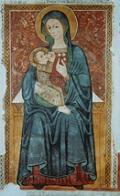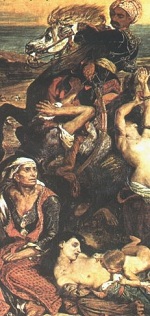
|
||||||||||||||||||||||||||||||||||||||||||||||||
|
|
Traditions & Folklore
Popular traditions are the mirror of the soul of Calabrians, reflecting the region's entire history, with its domination by others, invasions and constant danger, hence the geographical and social isolation of mountains populations and a frugal but dignified family economy. At the basis of each tradition is an attitude of resigned reliving the past, a sort of gentle melancholy bordering on regret. A very old ritual still taking place today. A not so similar tradition exist in Palmi and Polistena ( Reggio di Calabria province) when penitents have clumps of sharp spiny twigs laid on their heads and bare shoulders. Tradition has it, to varying degrees, that many sanctuaries in the region were built on sites indicated by the Virgin Mary herself or the saint honored; this is said to be the case at the Marian sanctuary of Polsi (Reggio province on Aspromonte), at Melito Porto Salvo, where the Madonna of Pentedattilo fought for possession of the sacred images.
Below the festa della Madonna del Carmine at Marina di Gioiosa Jonica In the Albanian communities prevalently along the foothills overlooking the Plain of Sibari, many village weddings are traditional affairs, solemn and impressive, celebrated according to Greek Orthodox rite, with the gleaming gold of the priest's vestments and the splendid costumes of the couple, crowned with garlands and flowers. Many other traditions date back to the long period of the Turkish raids; The legend of Donna Canfura, at Palmi and Nicotera, has similar Some people also belive in the evil eye and the protection of a Seminara "babbulato"; and avoid setting out on a journey on Fridays and Tuesdays, thought to be unlucky days. Hunting the swordfish and the traditions linked with this seem to be particularly important. When the swordfish has been harpooned, silence falls over the boat. You might also be interested to learn about : Calabria Ethnic minorities | Calabria Grecanica | Traditions & Folklore | Costumes of Calabria | Traditions and Progress | A culture of skills | Art in Calabria | Archaelogy |
La Calabria fu per secoli terra di conquista da parte di molte popolazioni straniere, ognuna delle quali ha lasciato un'impronta indelebile negli usi e costumi della regione. Le tradizioni popolari ed il folklore rappresentano per la Calabria una grande ricchezza e mutano di zona in zona.
Una forte rilevanza assumono le manifestazioni folkloristiche nelle comunità albanesi insediatasi intorno a Castrovillari, Acquaformosa, San Basile, Spezzano, Firmo e Lungro. Qui si conservano ancora, la lingua, i costumi, gli usi e i riti della terra d'origine. A San Cosmo Albanese, per esempio, la festa patronale ha delle caratteristiche albanesi, come il rito nuziale impostato sul ratto della sposa, sull' "iconastasi", la passeggiata in cerchio di tutto il corteo per tre volte intorno all'altare. Inoltre le rappresentazioni ripercorrono l'esodo che queste popolazioni hanno intrapreso secoli addietro ed esaltano l'eroe nazionale Scanderberg. Un'altra piccola minoranza linguistica, con tradizioni e costumi propri, si trova a Guardia Piemontese. Essa venne fondata da gruppi di esuli piemontesi di religione valdese, venuti dalle valli Pellice e Angrogna intorno al 1200, per sfuggire alle persecuzioni del Medioevo. Nella provincia di Reggio Calabria si conservano ancora usi e costumi del mondo greco nella comunità cosiddetta "grecanica" di Gallicianò, Roghudi, Bova, Roccaforte del Greco e Palizzi, dove si svolgono festival dedicati alla Magna Grecia. Queste tre isole linguistiche conservano antiche tradizioni nella produzione artigianale, nei riti religiosi e nelle sagre. Molte manifestazioni sono legate alla religione: da segnalare i riti della Settimana Santa quali quello dei Vattienti a Nocera Terinese e dell'Affruntata nelle province di Vibo Valentia e Reggio Calabria. Particolarmente suggestive sono le Feste in onore dei Santi Cosmo e Damiano a Drapia in provincia di Vibo Valentia e le celebrazioni in onore della Madonna nei centri costieri, dove si svolgono numerose processioni al mare. Da menzionare è quella di Capo Colonna, nel mese di maggio, con processione notturna dalla Cattedrale al Santuario di Capo Colonna a Crotone. Anche il Carnevale riveste in Calabria un ruolo molto importante, con recite, sfilate di carri allegorici e di antichi costumi che richiamano alle antiche usanze greche e latine. Molte farse rappresentano il personaggio di Carnevale come un ammalato in agonia, attorno al quale si muovono dottori in atteggiamenti buffi. La maschera tipica calabrese è quella di Giangurgolo, un personaggio risalente al sei-settecento. A rievocare un glorioso medioevo in Calabria è invece il Palio di Ribusa a Stilo, che viene disputato dagli arcieri, dai balestrieri e dai cavalieri in rappresentanza degli antichi casali di Camini, Guardavalle, Pazzano, Riace e Stignano e della contea di Stilo, con gare di tiro con l'arco. Al vincitore viene assegnato il palio dipinto a mano da un artista locale. Nel centro storico di Vibo Valentia si svolge invece il Palio di Diana, che con gare tra cavalieri e spettacoli di giullari e giocolieri permette alla città di rivivere un ritorno al passato. Numerose sono le sagre dei prodotti tipici locali, come quella della 'nduja a Spilinga, della cipolla rossa a Tropea, del vino, delle castagne e dei funghi. Particolarmente significativa la Festa dell'Emigrante, che si svolge in molte località calabresi per celebrare il ritorno dei molti corregionali residenti all'estero e in tutta Italia. Durante queste manifestazioni trovano spazio i vari spettacoli organizzati dai gruppi folkloristici della regione, i quali componenti si esibiscono in canti e balli popolari. La danza che meglio rappresenta lo spirito gioioso e festoso dei calabresi è la tarantella, che si balla in gruppi e in coppia come danza di corteggiamento. Gli strumenti musicali utilizzati sono il tamburello, la fisarmonica e l'organetto. |

|
||||||||||||||||||||||||||||||||||||||||||||||
|
||||||||||||||||||||||||||||||||||||||||||||||||



